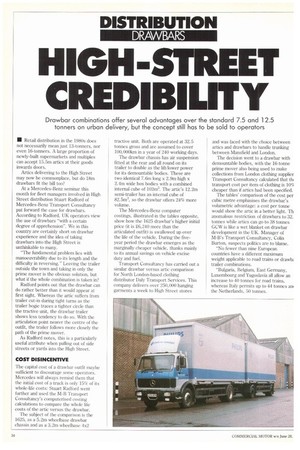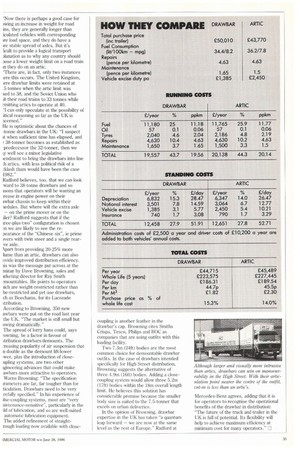HIGH STREET CREDIBILITY
Page 34

Page 35

If you've noticed an error in this article please click here to report it so we can fix it.
Drawbar combinations offer several advantages over the standard 7.5 and 12.5 tonners on urban delivery, but the concept still has to be sold to operators
• Retail distribution in the 1980s does not necessarily mean just 13-tonners, nor even 16-tonners. A large proportion of newly-built supermarkets and multiples can accept 15.5m artics at their goods inwards doors.
Artics delivering to the High Street may now be commonplace, but do 18m drawbars fit the bill too?
At a Mercedes-Benz seminar this month for fleet managers involved in High Street distribution Stuart Radford of Mercedes-Benz Transport Consultancy put forward the case for drawbars. According to Radford, UK operators view the use of drawbars "with a certain degree of apprehension". We in this country are certainly short on drawbar experience and the idea of taking drawbars into the High Street is unthinkable to many.
-The fundamental problem lies with manoeuvrability due to its length and the difficulty in reversing." Leaving the trailer outside the town and taking in only the prime mover is the obvious solution, but what if the whole combination is taken in?
Radford points out that the drawbar can do rather better than it would appear at first sight. Whereas the artic suffers from trailer cut-in during tight turns as the trailer bogie traces a tighter circle than the tractive unit, the drawbar trailer shows less tendency to do so. With the articulation point nearer the centre of the outfit, the trailer follows more closely the path of the prime mover.
As Radford notes, this is a particularly useful attribute when pulling out of side streets or yards into the High Street.
COST DISINCENTIVE
The capital cost of a drawbar outfit maybe sufficient to discourage some operators. Mercedes will always remind them that the initial cost of a truck is only 15% of its whole-life costs: Stuart Radford went further and used the M-B Transport Consultancy's computerised costing calculations to compare the whole life costs of the artic versus the drawbar.
The subject of the comparison is the 1625, as a 5.2m wheelbase drawbar chassis and as a 3.2m wheelbase 4x2 tractive unit. Both are operated at 32.5 tonnes gross and are assumed to cover 100,000km in a year of 240 working days.
The drawbar chassis has air suspension fitted at the rear and all round on its trailer to double as the lift/lower power for its demountable bodies. These are two identical 7.6m long x 2.9m high x 2.4m wide box bodies with a combined internal cube of 102m3. The artic's 12.2m semi-trailer has an internal cube of 82,5m, so the drawbar offers 24% more volume.
The Mercedes-Benz computer costings, illustrated in the tables opposite, show how the 1625 drawbar's higher initial price (it is 26,240 more than the articulated outfit) is swallowed up over the life of the vehicle. During the fiveyear period the drawbar emerges as the marginally cheaper vehicle, thanks mainly to its annual savings on vehicle excise duty and fuel.
Transport Consultancy has carried out a similar drawbar versus artic comparison for North London-based clothing distributor Daly Transport Services. This company delivers over 250,000 hanging garments a week to High Street stores and was faced with the choice between artics and drawbars to handle trunking between Mansfield and London.
The decision went to a drawbar with demountable bodies, with the 16-tonne prime mover also being used to make collections from London clothing supplier Transport Consultancy calculated that th. transport cost per item of clothing is 10q4 cheaper than if artics had been specified.
The tables' comparison of the cost per cubic metre emphasises the drawbar's volumetric advantage: a cost per tonne would show the artic in a better light. Th anomalous restriction of drawbars to 32. tonnes while artics can go to 38 tonnes GCW is like a wet blanket on drawbar development in the UK. Manager of M-B's Transport Consultancy, Colin Burton, suspects politics are to blame.
"No fewer than nine European countries have a different maximum weight applicable to road trains or drawlx trailer combinations.
"Bulgaria, Belgium, East Germany, Luxembourg and Yugoslavia all allow an increase to 40 tonnes for road trains, whereas Italy permits up to 44 tonnes an the Netherlands, 50 tonnes.
Now there is perhaps a good case for wing an increase in weight for road ins, they are generally longer than iculated vehicles with corresponding ire load space, and they do have a Ire stable spread of axles. But it's icult to provide a logical transport alanation as to why any country should 3ose a lower weight limit on a road train in they do on an artic.
There are, in fact, only two instances ere this occurs. The United Kingdom, ere drawbar limits were retained at 5 tonnes when the artic limit was sed to 38, and the Soviet Union who it their road trains to 33 tonnes while rmitting artics to operate at 40.
can only speculate at the possibility of [Weal reasoning so far as the UK is icerned."
He is optimistic about the chances of -tonne drawbars in the UK: "I suspect it when sufficient time has elapsed, and 38-tonner becomes as established as predecessor the 32-tonner, then we ly well see a minor legislative iendrnent to bring the drawbars into line :h artics, with less political risk of a kJash tham would have been the case 1982."
Radford believes, too, that we can look ward to 38-tonne drawbars and so 'sons that operators will be wanting an rease in engine power on their iwbar chassis to keep within their iedules. But where will the extra axle on the prime mover or on the iler? Radford suggests that if the wee-plus-two" configuration is chosen m we are likely to see the re pearance of the "Chinese six", ie prime Jivers with twin steer and a single rear'Are axle.
kpart from providing 20-25% more lume than an artic, drawbars can also ovide improved distribution efficiency. us was the message put across at the minar by Dave Browning, sales and irketing director for Ray Smith ..mountables. He points to operators fich are weight-restricted rather than be-restricted and yet use drawbars, ch as Beechams, for its Lucozade itribution.
According to Browning, 350 new awbars were put on the road last year the UK. "The market is still small but owing dramatically."
The spread of lorry bans could, says -owning, be a factor in favour of itribution drawbars/deinounts. The :reasing popularity of air suspension that n double as the demount lift/lower wer, plus the introduction of closeupling systems, are two other igineering advances that could make awbars more attractive to operators. Warns Browning: "The specification rameters are far, far tougher than for ticulation. Drawbars need to be very refully specified." In his experience of Ilse-coupling systems, most are "very aintenance-sensitive", particularly in the ld of lubrication, and so are well-suited automatic lubrication equipment. The added refinement of straightrough loading now available with close
coupling is another feather in the drawbar's cap. Browning cites Smiths Crisps, Tesco, Philips and BOC as companies that are using outfits with this loading facility.
Two 7.3m (24ft) bodies are the most common choice for demountable drawbar outfits. In the case of drawbars intended specifically for High Street distribution, Browning suggests the alternative of three 4.9m (16(t) bodies. Adding a closecoupling system would allow three 5.2m (17ft) bodies within the 18m overall length limit. He believes this solution has considerable promise because the smaller body size is suited to the 7.5-tonner that excels on urban deliveries.
In the opinion of Browning, drawbar expertise in the UK has taken "a quantum leap forward we are now at the same level as the rest of Europe." Radford at
Mercedes-Benz agrees, adding that it is for operators to recognise the operational benefits of the drawbar in distribution: "The future of the truck and trailer in the UK is full of potential. Its flexibility will help to achieve maximum efficiency at minimum cost for many operators." o












































































